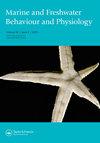对亚马逊河两种淡水蟹雄性生殖系统的调查:是否有精子塞或精子包形成?
IF 1.1
4区 生物学
Q3 MARINE & FRESHWATER BIOLOGY
Marine and Freshwater Behaviour and Physiology
Pub Date : 2018-07-04
DOI:10.1080/10236244.2018.1523678
引用次数: 6
摘要
摘要对亚马逊河淡水蟹Sylviocarcinus pictus和Dilocarcinus pagei的雄性生殖系统进行了解剖和组织化学比较,并进行了顺序交配的精子移植实验和精囊解剖检查。这两个物种的雄性生殖系统的解剖结构都是一个倒“U”形,由睾丸连接,从睾丸分离出一对输精管,分为前、中、后三个区域。Sylviocarcinus pictus和D. pagei表现出与东南亚淡水蟹科不同的共精性。两种毛趾蛛科的精液的组织化学成分是相似的,遵循大多数短掌蛛所描述的模式。通过交配实验和解剖结果,这些动物在与不同雄性进行多次交配时,不会出现精子塞,而是形成不同的精子包。本文章由计算机程序翻译,如有差异,请以英文原文为准。
An investigation into the male reproductive system of two freshwater crabs from the Amazon: is there a sperm plug or packet formation?
ABSTRACT The male reproductive system of Amazon freshwater crabs Sylviocarcinus pictus and Dilocarcinus pagei were described and compared in terms of anatomy and histochemistry In addition, sperm transfer experiments of D. pagei with sequential copulations were performed and the anatomy of the seminal receptacle was checked. The anatomy of the male reproductive system of both species is an inverted ‘U’ shape, connected by the testes, from which the pair of vas deferens divided into anterior, median and posterior regions depart. Sylviocarcinus pictus and D. pagei revealed coenospermia, which differed from the families of freshwater crabs in Southeast Asia. The histochemical composition of the seminal fluid is similar in both Trichodactylidae, following the pattern described for most Brachyura. Through the copulation experiments and anatomical results, these animals do not show a sperm plug, but rather form different sperm packs when engaging in multiple copulations with different males.
求助全文
通过发布文献求助,成功后即可免费获取论文全文。
去求助
来源期刊

Marine and Freshwater Behaviour and Physiology
生物-海洋与淡水生物学
CiteScore
2.10
自引率
0.00%
发文量
9
审稿时长
>12 weeks
期刊介绍:
Marine and Freshwater Behaviour and Physiology is devoted to the publication of papers covering field and laboratory research into all aspects of the behaviour and physiology of all marine and freshwater animals within the contexts of ecology, evolution and conservation.
As the living resources of the world’s oceans, rivers and lakes are attracting increasing attention as food sources for humans and for their role in global ecology, the journal will also publish the results of research in the areas of fisheries biology and technology where the behaviour and physiology described have clear links to the contexts mentioned above.
The journal will accept for publication Research Articles, Reviews, Rapid Communications and Technical Notes (see Instructions for authors for details). In addition, Editorials, Opinions and Book Reviews (invited and suggested) will also occasionally be published. Suggestions to the Editor-In-Chief for Special Issues are encouraged and will be considered on an ad hoc basis.
With the goal of supporting early career researchers, the journal particularly invites submissions from graduate students and post-doctoral researchers. In addition to recognising the time constraints and logistical limitations their research often faces, and their particular need for a prompt review process, accepted articles by such researchers will be given prominence within the journal (see Instructions for authors for details).
 求助内容:
求助内容: 应助结果提醒方式:
应助结果提醒方式:


